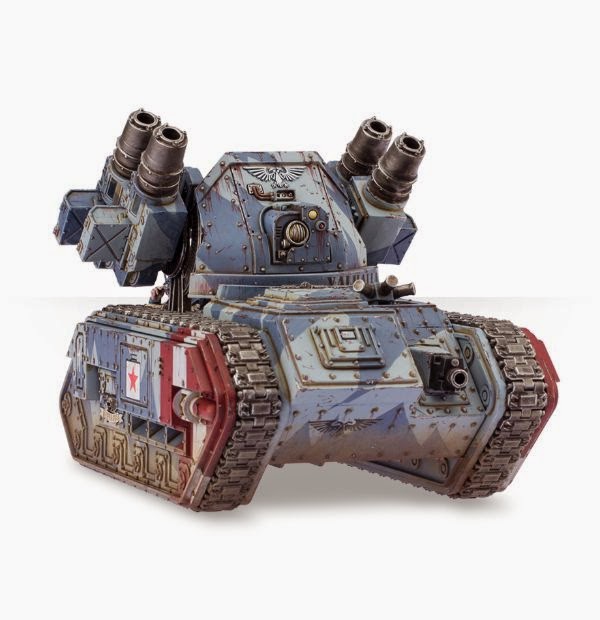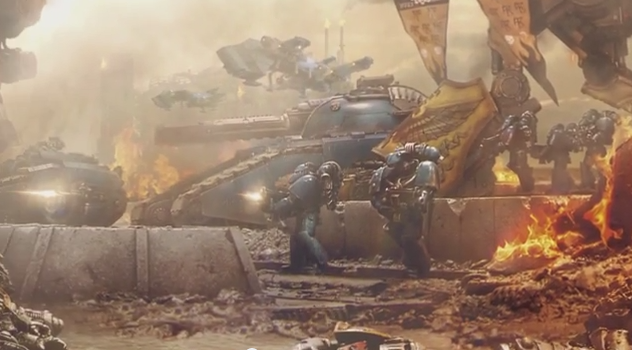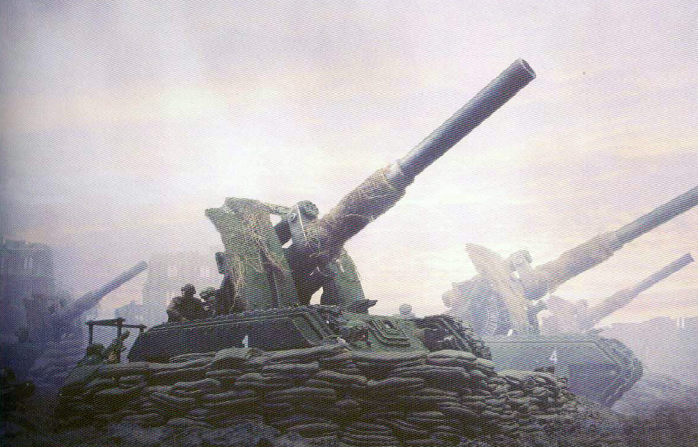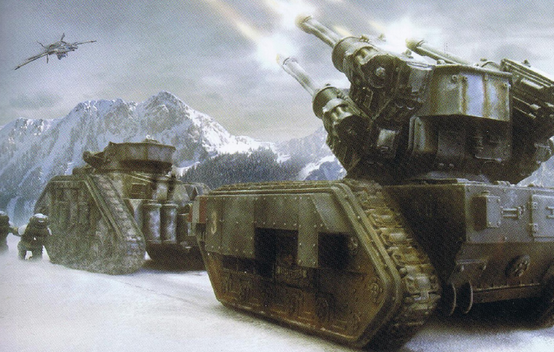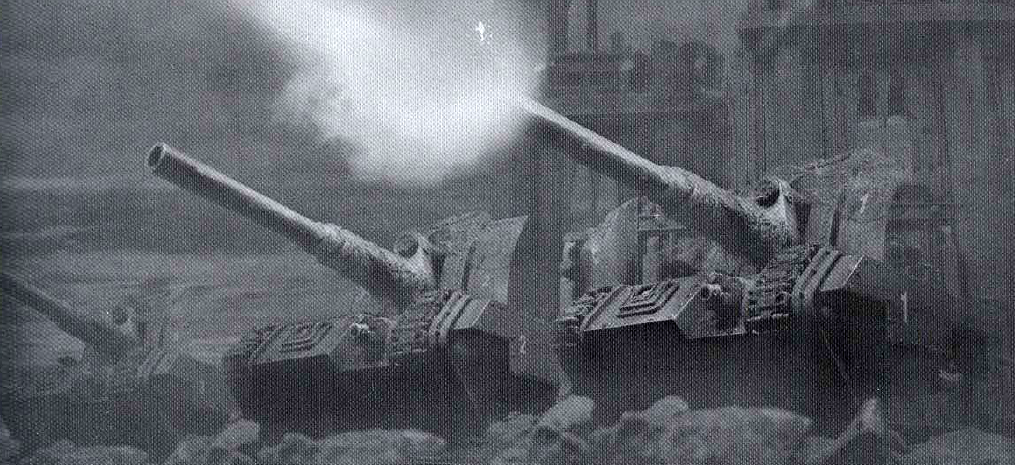40K Tactics: Astra Militarum – Wyverns

Few units in the game are quite as devastating as Wyverns, and today we explore the Astra Militarum’s latest killer.
Greetings ladies and gentlemen and welcome to the second last addition to my seemingly insufferable Astra Militarum Tactica series! Of the handful of new units added in the latest Imperial Guard codex, the Wyvern is by far the most competitive option and has swiftly replaced veteran artillery batteries such as the Griffon and Basilisk as the best artillery tank available to the Imperium’s most numerous defenders. There are few units in the game quite as devastating as Wyverns even with the 7th Edition rules ushering in more vehicles than were seen in 6th Edition, and no competitive Astra Militarum list has a place without at least one of these suppression tanks. I hope you enjoy this article!
Wyverns
Overview
Ah, the Wyvern, bane of infantry and really anything with a Toughness value short of a monstrous creature or Centurions. Even if Ork Lobbas and various other choices remain as strong competitors or superiors to the Wyvern, it is nonetheless one of the best artillery (as in role, not unit type) units in the game and the 7th Edition buffs to vehicles have not changed its standing one bit. For just over half the price of a Basilisk, a Wyvern has identical survivability seeing as it shares the Chimera chassis – for the uninitiated this means that it is a three hull point, open-topped tank with AV 12/10/10. Like the Basilisk, it either needs to sit completely out of sight to make the most of its Barrage rules and the ability to fire indirectly, or sit behind good cover with the Camo-Netting upgrade to ensure it can survive the inevitable backlash it will draw from any sane opponent. The reason this tank is so coveted and pops up in almost any competitive Astra Militarum list – even if that same army features Thudd Guns! – is because there is literally no better way to spend so few points on a unit so good in the codex. While any number of the Leman Russ variants or other artillery types can obviously prove more useful in a specific force, for general efficiency and reliability there is simply no Heavy Support slot in the codex proper that matches a Wyvern point-for-point. This is because of the Wyvern’s two individual Stormshard Mortars, each a devastating yet deceiving weapon that fooled quite a few early adopters of the codex into thinking it was too weak to be of great use.
Each Stormshard Mortar fires two shots that use the small blast template with a low Strength 4 and terrible AP6. Four small blasts with this profile is essentially the equivalent of four Space Marine Missile Launchers firing frag missiles, but then you add in the many special rules applying to each Stormshard Mortar and you will quickly see why the Wyvern is so brutal. Each shot benefits from re-rolls to wound via Shred, cancels out cover saves with the Ignores Cover special rule, while it can also be fired without line of sight and resolves wounds from the centre of the template because of its Barrage classification. Not only does the Wyvern ignore all cover saves and re-roll failed to wound rolls, but as its two Stormshard Mortars are twin-linked it also re-rolls all “failed” to hit rolls in an attempt to get more hits with the blasts. As it uses the Barrage rules for resolving hits and wound allocation this also means that the latter three of the four small blasts are undertaken by “flipping” off of the initial blast. While this can lead to each small blast hitting nothing if there is some incredibly unlucky scatter rolling, generally this means a Wyvern will average a tonne of hits against most squad types. By having re-rolls on virtually every dice roll the Wyvern directly participates in as well as ignoring cover saves that would otherwise deny this artillery piece numerous kills against weaker infantry, the Wyvern is one of the only units in the game that requires absolutely no support outside of any necessary defensive measures. That the unit doesn’t need any help from your psychic powers or other support abilities means you can virtually throw it into an army list with no fear of it failing, while its damage capabilities are absolutely ridiculous. From extensive personal, anecdotal and theoretical evidence, the Wyvern tears apart any infantry squad short of Terminators – and even these will usually suffer a few casualties from its fusillade. At its points cost it is by far the best infantry hunter in the Astra Militarum codex, firing from long range, having guaranteed efficiency with re-rolls for everything, and ignoring cover saves to deal with annoying Nurgle Daemons or other cover-camping squads.
In this next section of the article, I wanted to feature a throw-back to a still very relevant article I published way back on the 28th of April, suitably titled “The Wondrous Wyvern”. Of all the points I have already made here, they are nothing if not provided proper context through comparisons to the Wyvern’s chief competitors. To keep those comparisons in line with the 7th Edition context of this Wyvern Tactica article, I have also included the now famous Ork Lobba and its capabilities into the mix. I still think it is fair to say that the Wyvern is one of the best artillery units in Warhammer 40,000 and comfortably sits alongside the Heavy Quad Launcher, Lobba and Thunderfire Cannon as the front-runners for that prestigious title. In fact, once one considers that Prescience is no longer the easily obtained re-roll generator it was in 6th Edition, you could say the Wyvern has an even greater presence in 7th Edition, though obviously this is counter-balanced by the increasing relevance of vehicles in an even more heavily objective-based game.
Of course, this comparison chart not only points out how amazing the “all-in-one” package a Wyvern is but also the resurgence of Ork Lobbas; they are even more insanely cheap than Wyverns but obviously lack the efficiency of the latter. If you take three Lobbas each with Ammo Runts for just a few points shy of one Wyvern, you will have one less shot but each will be resolved at one greater Strength and AP, with twin-linking for three effective turns (you choose to re-roll one to hit roll with the first Lobba fired each turn, firing a different Lobba each time until you expend the re-rolls). Of course, the trade-off between Shred and Ignores Cover versus Strength 5 and AP5 will generally favour the former, though that comes with the distinction that each of the latter shots uses a large blast as opposed to the formers’ small blasts. A Wyvern is more reliable by nature of having Shred and having Ignores Cover so that it isn’t neutered by cover saves, but the Lobbas are more useful against vehicles and similarly don’t really need support to function well. As impressive as the Wyvern is, you can be sure I will be discussing Mek Guns using Lobbas in my Ork Tactica in detail as they are a superb choice as well!
Wyvern
*Cost = 13 Meltabombs
*Survivability = Armour Value 12/10/10, Hull Points 3
*Accuracy = Ballistic Skill 3, Twin-Linked
*Rate of Fire = Four Small Blasts
*Range = 48″
*Damage Output = Strength 4 AP6, Shred
*Barrage = Yes / Ordnance = No / Ignores Cover = Yes
*Unit Size = 1-3
*Additional Effects = Not applicableHeavy Quad Launcher (Thudd Gun)
*Cost = 11 Meltabombs
*Survivability = Toughness 7, Wounds 2-4 (Upgradeable), Armour Save 3+
*Accuracy = Ballistic Skill 3
*Rate of Fire = Four Small Blasts
*Range = 60″
*Damage Output = Strength 5, AP5
*Barrage = Yes / Ordnance = No / Ignores Cover = No
*Unit Size = 1-3
*Additional Effects = Pinning tests inflicted by Thudd Gun suffer -1 Leadership penaltyAdvertisementWhirlwind
*Cost = 13 Meltabombs
*Survivability = Armour Value 11/11/10, Hull Points 3
*Accuracy = Ballistic Skill 4
*Rate of Fire = One Large Blast
*Range = 48″
*Damage Output = Variable (Strength 5 AP4 and Strength 4 AP5)
*Barrage = Yes / Ordnance = Yes / Ignores Cover = Variable (No on first profile, Yes on second profile)
*Unit Size = 1
*Additional Effects = Not applicableThunderfire Cannon
*Cost = 20 Meltabombs
*Survivability = Toughness 7, Wounds 2, Armour Save 3+
*Accuracy = Ballistic Skill 4
*Rate of Fire = Four Small Blasts
*Range = 60″
*Damage Output = Variable (Strength 6 AP5, Strength 5 AP6, Strength 4 AP-)
*Barrage = Yes / Ordnance = No / Ignores Cover = Variable (No on first and third profile, Yes on second profile)
*Unit Size = 1
*Additional Effects = Strength 4 shell causes difficult or dangerous terrain testsSubscribe to our newsletter!Get Tabletop, RPG & Pop Culture news delivered directly to your inbox.By subscribing you agree to our Terms of Use and Privacy Policy.Night Spinner
*Cost = 23 Meltabombs
*Survivability = Armour Value 12/12/10, Hull Points 3, Jink
*Accuracy = Ballistic Skill 4
*Rate of Fire = One Large Blast
*Range = 48″
*Damage Output = Strength 7 AP6 (Monofilament potential AP1 wounds on 6s)
*Barrage = Yes / Ordnance = No / Ignores Cover = No
*Unit Size = 1
*Additional Effects = Not applicableShadow Weaver
Advertisement*Cost = 6 Meltabombs
*Survivability = Toughness 7, Wounds 2, Armour Save 3+
*Accuracy = Ballistic Skill 4
*Rate of Fire = One Small Blast
*Range = 48″
*Damage Output = Strength 6 AP6 (Monofilament potential AP1 wounds on 6s)
*Barrage = Yes / Ordnance = No / Ignores Cover = No
*Unit Size = 1-3
*Additional Effects = Not applicableSkull Cannon
*Cost = 25 Meltabombs
*Survivability = Armour Value 12/12/10, Hull Points 3, Open-Topped, 5+ Invulnerable Save
*Accuracy = Ballistic Skill 5
*Rate of Fire = One Large Blast
*Range = 36″
*Damage Output = Strength 8 AP5
*Barrage = No / Ordnance = No / Ignores Cover = Yes
*Unit Size = 1
*Additional Effects = Friendly Daemon units charging target gain assault grenade bonusesBiovores
*Cost = 8 Meltabombs
*Survivability = Toughness 4, Wounds 3, Armour Save 4+
*Accuracy = Ballistic Skill 3
*Rate of Fire = One Large Blast
*Range = 48″
*Damage Output = Strength 4 AP4
*Barrage = Yes / Ordnance = No / Ignores Cover = No
*Unit Size = 1-3
*Additional Effects = Missed shots generate Spore Mine unitsGriffon
*Cost = 15 Meltabombs
*Survivability = Armour Value 12/10/10, Hull Points 3, Open Topped
*Accuracy = Ballistic Skill 3, Twin-Linked
*Rate of Fire = One Large Blast
*Range = 48″
*Damage Output = Strength 6 AP4
*Barrage = Yes / Ordnance = Yes / Ignores Cover = No
*Unit Size = 1-3
*Additional Effects = Not applicableAdvertisementLobba
*Cost = 3 Meltabombs + 3 Points
*Survivability = Toughness 7, Wounds 2, Armour Save 3+
*Accuracy = Ballistic Skill 3
*Rate of Fire = One Large Blast
*Range = 48″
*Damage Output = Strength 5 AP5
*Barrage = Yes / Ordnance = No / Ignores Cover = No
*Unit Size = 1-5
*Additional Effects = Not applicable
How to Equip Them
A Wyvern needs no upgrades for similar reasons to a Basilisk; it will rarely if ever need to move with its 48″ range and capability to fire indirectly regardless of enemy proximity, while the firepower provided by its pair of Stormshard Mortars are more than enough to devastate any infantry unit. Besides, this tank is so insanely cheap for what it does and that is why it ranks as arguably the most cost-effective unit in the game – it is fully self-sufficient and needs no support abilities or upgrades to maximise its damage potential and usefulness. Spending extra points on a tank that has essentially already been “perfected” in its role is effectively a waste and as such I recommend leaving these entirely devoid of any upgrades. About the most I would ever bother with on a Wyvern is Camo-Netting and that is only if you have some form of barricade like an Aegis Defence Line that you plan on including in your army list. Using that or another type of fortification in conjunction with the Camo-Netting will provide the Wyvern with a strong cover save while simultaneously allowing it to fire directly at its chosen targets – at least more so than if it was hiding – so that it can make use of its Ballistic Skill to further increase its accuracy.
Best Uses
Let’s be perfectly honest here; any non-vehicle unit you see that has Toughness 5 or lower is potential prey for a Wyvern. When you have four twin-linked small blasts to play with that re-roll to wound at Strength 4, even units with high Toughness like Ogryns will have a hard time coming out of a bombardment without some casualties. Whether it be tiny units of Eldar Rangers, combined Infantry Squads from this very codex or Space Marine Terminators, a Wyvern can inflict some serious damage on the opposition and will work even against well armoured foes because of the sheer amount of wounds it can reliably inflict. The key word here is efficiency; a Wyvern generally averages around fifteen or more hits against standard 20mm based models that are spread out somewhat, and something like seven or eight against 40mm based models. Each of those hits re-rolls to wound, is AP6 and ignores any cover saves the models might benefit from, forcing them to use their armour or invulnerable saves where applicable. Against Space Marine Tactical Marines, those fifteen hits will translate to roughly eleven wounds for an average of four casualties, rounding up on all fractions. Against Tyranid Termagants or even Ork Boyz lacking ‘Eavy Armour, the average casualties inflicted increase to around thirteen and elven, respectively – again factoring in rounded-up fractions.
Depending on the spacing of heavily armoured units such as Terminators, one to two casualties per volley are par for the course and not the exception; how refreshing is it to see a unit that makes its points back in one shooting phase in almost every single game it is used in? Sarcasm aside, there’s very little the Wyvern isn’t afraid of shooting at; Space Marine Bikers make good targets as Shred helps to negate their high Toughness advantage, while larger units with weaker saves will be torn apart by the sheer number of hits each Wyvern can cause. Just try not to move the Wyvern and keep it out of sight or at least make the most of its impressive 48″ range; it is a very fragile unit with AV 12/10/10 and three hull points with the Open-Topped classification and moving it even slightly will force one of its two Stormshard Mortars to Snap Fire (meaning the gun won’t be able to fire whatsoever). Even if it fires indirectly you will find the twin-linking makes it a seriously accurate ranged unit, while its incredible efficiency and reliability means you can simply throw one or two into an army list and never have to worry about supporting it given their ridiculously low cost. As for whether to run them in a squadron or not, this all comes down to how your Heavy Support slots shape up; if you already have two slots filled, running a pair of Wyverns together isn’t a bad idea as they are guaranteed to severely damage whatever they target. On the other hand, just one shooting at a given unit is often enough to seriously cripple them and so I do recommend running them separate wherever possible; after all, no opponent is going to be happy if they learn they have to invest units into destroying two separate vehicles rather than just one squadron! While 7th Edition’s detachments give you the flexibility to effectively ignore the Force Organization chart (both metaphorically in this case and literally if you count Unbound) if you don’t have the required HQ and Troops to fill those mandatory slots then having the option to take squadrons does give you some added flexibility that many other codices lack entirely.
Thank you all for reading this article focusing on that most devastating of the new Astra Militarum units, the “Wondrous” Wyvern. While I have spoken at great length about how successful it is on numerous occasions in the past, it is a testament to this tanks’ enduring competitive usage that I can still find new ways to describe its many and various uses. If you are an Astra Militarum player and lack one or more of these fine artillery pieces, please do yourself a favour (and your opponents a disservice) by grabbing one – they really are amazing!
Thanks again for reading my Wyvern article and I hope you enjoy yourself this week!

